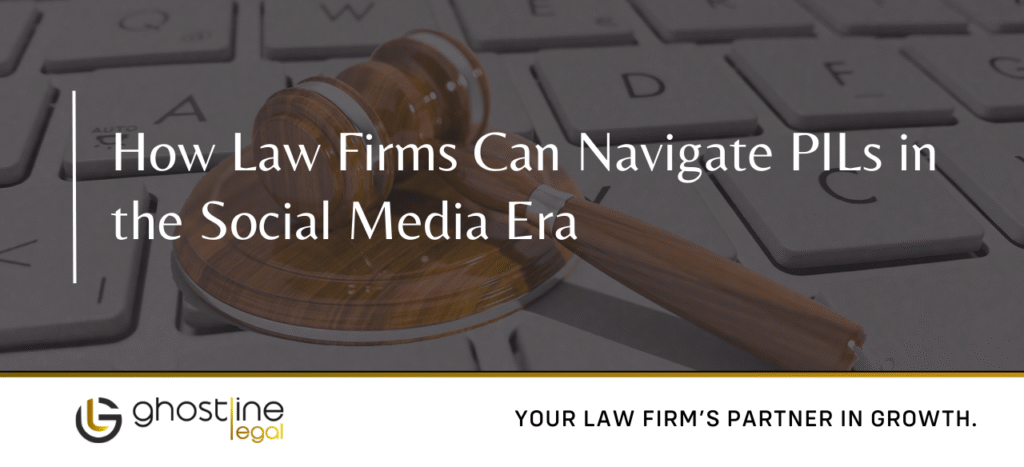This article has been authored by team Ghostline Legal.
When a public interest litigation (PIL) hits the headlines, the courtroom is only one of the arenas where the case is fought. The other is online – on Twitter threads, Instagram reels, LinkedIn posts, and news portals. For law firms advising on such matters, the challenge is not just about winning legal arguments. It’s about guiding clients through the chaos of public opinion, rapid-fire media cycles, and activist messaging that can shape how the case is perceived before it is even heard in court.
This is where a crisis playbook comes in. A structured approach to communication during PILs and high-visibility social media litigation can help law firms protect reputations, maintain message discipline, and avoid costly missteps.
Let’s break down what that looks like in practice.
Why PILs and Social Media Collide
PILs often revolve around issues that touch nerves: environment, education, healthcare, labor rights, or freedom of speech. These are not quiet legal disputes. They are inherently political, emotional, and designed to capture attention.
Add social media into the mix, and the speed at which narratives form is staggering. A single tweet can spark outrage. A viral clip can cement a perception that no later court ruling can fully undo. By the time a case is argued, the public may already have made up its mind.
This is why legal strategy must go hand in hand with communication strategy.
The Core of a Crisis Playbook
A crisis playbook isn’t a bulky manual full of theories. It’s a practical, action-ready toolkit that ensures everyone on the advisory team knows what to do when the heat turns up. Here are its essentials:
1. Rapid-Response Content Plans
- Draft holding statements before they’re needed.
- Maintain templates for common questions and allegations.
- Prepare quick explainer pieces to share context without sounding defensive.
- Set internal approval processes so responses don’t get stuck in endless reviews.
2. Reputation Management Protocols
- Audit the client’s existing public footprint—what’s already out there?
- Monitor news and social chatter in real time.
- Correct misinformation promptly, but don’t feed trolls.
- Identify credible voices (academics, experts, former judges, NGOs) who can weigh in independently.
3. Message Discipline
- Define three to four key messages and repeat them consistently.
- Avoid jargon and keep explanations accessible.
- Train spokespersons—lawyers, clients, or external advocates—so they don’t go off-script under pressure.
- Stress-test the messaging by role-playing tough media questions.
Rapid-Response Content Strategies
Speed matters more than polish. During social media storms, silence is often seen as guilt. But rushing out sloppy or inconsistent responses is just as dangerous. The balance is tricky.
Be ready with facts. Having a bank of verified data points helps cut through noise.
Use plain language. Explaining a PIL in everyday terms makes it harder for opponents to twist the story.
Segment platforms. What works on LinkedIn (professional, measured, analytic) won’t land on Twitter (snappy, shareable).
Think multimedia. A short video or infographic often travels further than a PDF statement.
The goal is to stay ahead of the narrative, not trail behind it.
Reputation Management in the Age of Hashtags
When cases turn into hashtags, the reputational stakes rise. Firms advising in these moments have to see the whole board: not just what’s said in court, but how it resonates in public.
Pre-crisis mapping. Before litigation escalates, map likely critics, allies, and journalists who will engage.
Real-time dashboards. Use monitoring tools to catch trends before they spiral.
Narrative framing. Position the client’s actions in a broader context – lawful, principled, and part of a bigger debate – rather than only as reactive defenses.
Long tail care. Even after headlines fade, search results remain. Ensure that balanced and factual content continues to surface.
The Discipline of Message Control
In high-visibility matters, everyone wants to speak. Clients, junior lawyers, outside supporters, sometimes even family members. Without message discipline, a single stray comment can undo weeks of careful strategy.
Firms should:
Set boundaries. Clearly define who can speak publicly.
Brief often. Update all stakeholders on developments so they don’t rely on rumors.
Rehearse. Run simulations where spokespersons face hostile questions.
Stay human. Robotic lines won’t cut it. Empathy and clarity resonate more than sterile legalese.
Common Pitfalls to Avoid
Even experienced teams stumble without a playbook. Some common mistakes:
Overlawyering communications. Legal accuracy is vital, but excessively technical statements alienate audiences.
Ignoring emotion. Many PILs hinge on deeply felt issues. A purely rational tone can come across as cold.
Feeding outrage. Responding to every provocation boosts visibility for hostile voices. Pick battles wisely.
Assuming the court of law will outweigh the court of public opinion. Both matter, and both require strategy.
Building the Playbook: A Step-by-Step Snapshot
Assemble the team. Include lawyers, PR professionals, digital strategists, and researchers.
Define scenarios. Identify possible crises—from misinformation campaigns to viral protests.
Draft response flows. Who approves what, and how quickly?
Test under pressure. Simulate crises before real ones hit.
Update regularly. Laws, platforms, and public mood shift. The playbook should too.
Why This Matters
PILs and social media-driven litigation are unlikely to slow down. If anything, they will grow sharper, faster, and more public. For law firms, being unprepared is no longer an option.
A well-structured crisis playbook isn’t about spin. It’s about clarity, accountability, and foresight. Done right, it helps firms protect clients, support public understanding, and preserve trust in the legal process—both inside and outside the courtroom.
Build credibility for your law firm with strategic PR – get started now!








